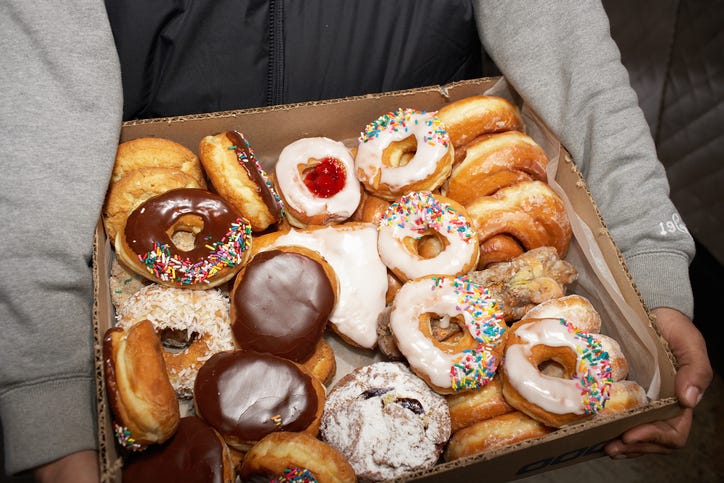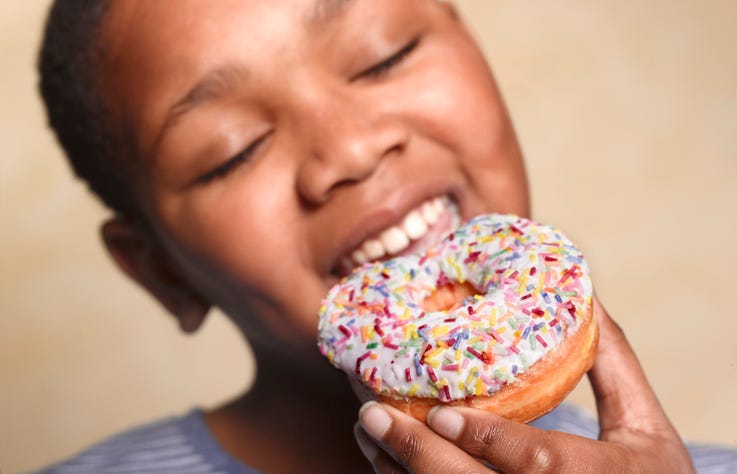If You Give a Kid a Doughnut
It's going to be very delicious and good for both of you.
Heads up! Corinne and I are recording your February AMA episode this week. Send us all your questions here.
Disclaimer: You’re reading this column because you value my input as a journalist who reports on these issues and therefore has a lot of informed opinions. I’m not a healthcare provider, and these responses are not meant to substitute for medical or therapeutic advice.

Q: My two year old has really gotten into imaginative play lately, and has been asking for stories of various types. Over the last couple of weeks, he has been asking multiple times a day for stories about him and his friends going to a doughnut shop, which involve the selection of doughnuts of different colors which they then bring to family, friends, or teachers. It's pretty cute and I have no idea where it came from, because my partner and I are not that into doughnuts, so he may have had part of a doughnut at Chanukah but that's basically it. He doesn't seem to connect the doughnut shop stories with him going to a real doughnut shop, and I genuinely cannot tell if this obsession is more about the fun colors of the doughnuts and imagining giving gifts to his friends or if he really wants to eat a doughnut.
So my question is: Should I take him to go get doughnuts? As I said, I don't really like them (mostly because I feel sick from the sugar and then am starving 20 minutes later) and the nearest place is kind of a pain to get to, so it's not really something I'm thrilled about adding into our routine and then be a thing he wants to do all the time. But if he really is obsessing about doughnuts (rather than some abstract idea of a doughnut shop), then the kid should get to have some doughnuts.
When I was a kid, doughnuts were definitely on the list of "evil fattening foods,” so I'm having trouble trusting my instincts here about what is reasonable and what is diet culture.
I expect every reader of Burnt Toast to unite with me here and say: Take this darling child out for doughnuts! I cannot imagine more adorably wholesome content than your kiddo’s sweet fantasy of picking out doughnuts for everyone he loves. And I cannot wait to hear how excited he is when he goes to a real doughnut shop and sees all of the awesome kinds of doughnuts! (For real. Can you send a photo? We’re invested now.)
I mean, I guess there is a small risk here that the actual doughnut shop will fail to live up to his vivid imagination. He has clearly concocted some super exciting flavor options. But emphasis on small, because we are talking about doughnuts, which are utterly delicious. One pro tip from someone whose kids are Dunkin’ Donut connoisseurs; go early in the day when they’ll have the best selection. There is nothing sadder than a Dunkin’ around 4pm, when the bakery shelves are almost bare and even the plain glazed is looking stale.
But now let’s get into the anxieties your question is articulating. You grew up with doughnuts on the “evil fattening foods” list, which it sounds like you are both chafing against now and still feeling somewhat constricted by. It’s hard to let go of those old food rules. But as I’ve reported plenty of times before, restriction breeds fixation. Letting kids have the treat they are excited to eat is the best strategy for ensuring that they don’t develop a scarcity mindset about that food, and can just eat it (or not!) in a joyful, non-fraught way. I also relate to your fear that going to an out-of-the-way doughnut shop once will result in daily requests to trek back there because toddler obsessions get intense, man. (Ask me about the yellow rain boots one of my children wore in every kind of weather for the entirety of her third year.) But it may not play out this way. “Eating doughnuts with your child may decrease his focus on them,” says Anna Lutz, RD, a dietitian who specializes in family feeding dynamics and disordered eating. “You may go once, and that's that. He may want to go several times and then as the newness wears off, he’ll want to go less. You never know what will happen, but you can trust your son and yourself to figure this out.”
It sounds like you’re also concerned that it might be somehow bad parenting to offer your child a real doughnut to eat if he isn’t specifically asking to eat one. If, as you say, he is maybe just excited about the fun colors doughnuts come in and the idea of sharing them with friends, and doesn’t fully grasp that they are edible. I often hear some version of this from parents of toddlers, especially one- and two-year-olds who aren’t yet in any kind of formal childcare, so caregivers at home still have pretty total control over which foods their kids are offered. I’ve heard parents humblebrag that their toddler thinks a “cookie” means an organic, sugar-free fig bar because they’ve never seen an Oreo, or that they “just don’t have any interest in candy!” And Kid Food Instagram (plus mom groups, plus pediatricians, plus wherever else you’re getting your intel on feeding kids) can convince us that this means we should only ever offer “healthy” foods, and try to keep treats away from little ones for as long as possible.

“There is a myth that if you introduce chocolate ‘too soon,’ your child is doomed to never like another food,” says Amy Palanjian of YummyToddlerFood, who hears from thousands of toddler parents every week, many of whom share this anxiety. “This is all about parental fear and feeling like we have to narrowly restrict young children in order to set their tastebuds up for ‘success,’ which is to say, try to foster preferences for the foods our culture deems ‘better.’”
Here’s the thing: Yes, right now, you have total control and your child can only eat the foods you put in front of him. But your time in this bubble is brief. You have maybe a year, tops, before he’s regularly offered food from people who are not you, whether that’s snack at preschool or cupcakes at birthday parties. (And almost anyone with multiple kids can tell you: That this window exists at all is strictly a first kid phenomenon.) While there’s no inherent harm in having a kid wait until age 3 to try their first doughnut, there’s also no need to draw an arbitrary line around treats just because it may not yet have occurred to him to eat them.
In fact, there is even a benefit to doing it now, with you. Kids should know and trust that joyful eating happens regularly in their lives and with their caregivers. (To be clear: I’m not implying that your regular shared meals are joyless; treats are just one way to engage in joyful eating. But they are an important and highly accessible way!) “This is how we counter the diet culture BS,” says Amy. “By welcoming all kinds of foods into our homes and modeling that we trust ourselves to eat all sorts of foods.” This is what prevents kids from fixating; from needing to sneak food later on; from being the child on the playdate that inhales the sleeve of Oreos because they never get that kind of food at home. And what a gift, to get to share your child’s first doughnut or first-any-treasured-food with them.
I know that last part might feel like a sticking point if you truly dislike doughnuts. So I also want to dig a little deeper into your parenthetical comment about how you feel when you eat doughnuts: “Sick from the sugar and then starving 20 minutes later.” I would never deny your lived experience of eating a food, but it can be hard to tell when our response to a formerly banned food is purely physiological and when it’s also diet culture-fueled. So I asked Anna for her dietitian’s take on this, and her response might blow a lot of your minds.



